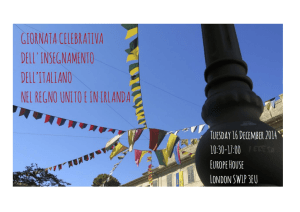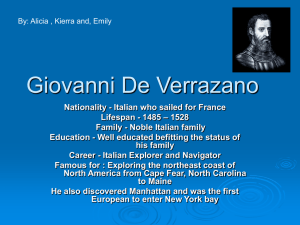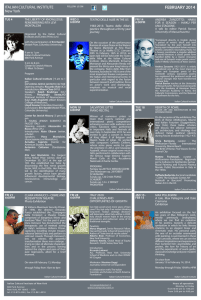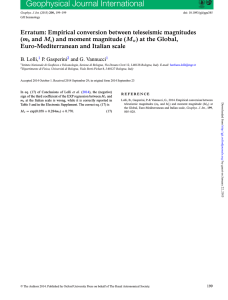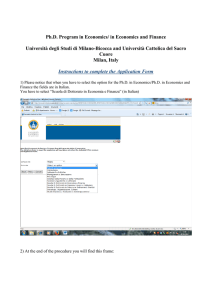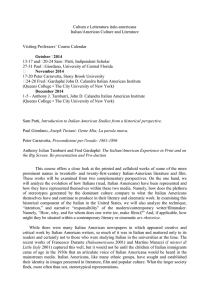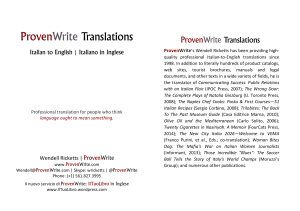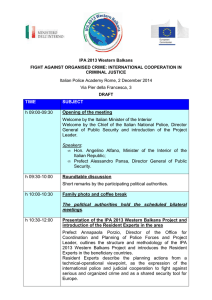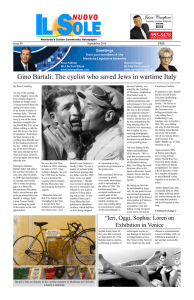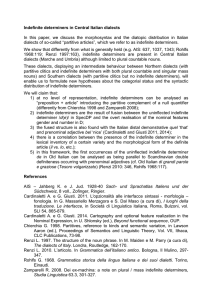SINDONIIP_Erasmus_Program – Copia
advertisement
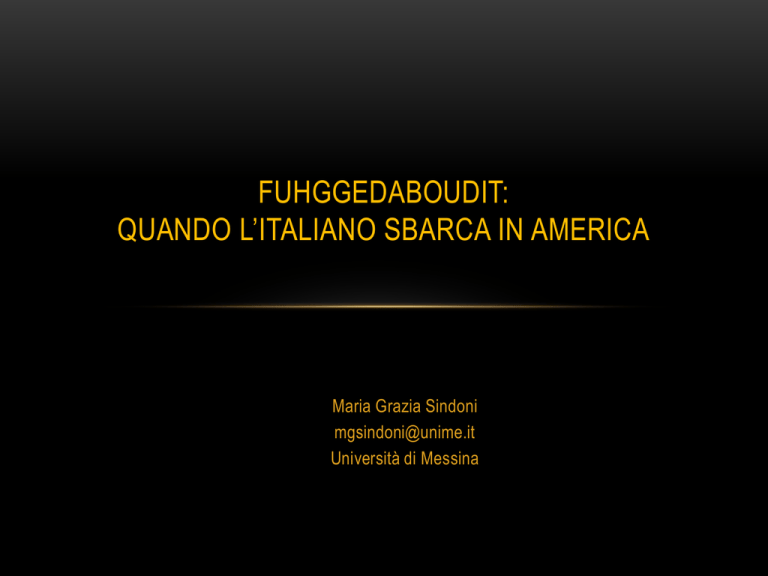
FUHGGEDABOUDIT: QUANDO L’ITALIANO SBARCA IN AMERICA Maria Grazia Sindoni mgsindoni@unime.it Università di Messina IN BREVE… • 1a parte • La rappresentazione: quali strategie, metodi, obiettivi? • La rappresentazione: quali interessi e quali ideologie? • Esempi di rappresentazione • 2a parte • Studio sull’autopercezione delle identità culturali di italoamericani di cosiddetta «seconda generazione» LA RAPPRESENTAZIONE • Linguistica e semiotica • De Saussure -> strutturalismo; post-strutturalismo • Semiotica • Foucault, Lévi-Strauss, Barthes • Barthes -> significato, significante -> testo -> interpretazione • Studi semiotici <-> studi sociosemiotici (Halliday 1978) <-> studi multimodali (Kress e van Leeuwen 1996, 2001, 2002, 2006, Kress 2010, etc.) LEGGERE LE IMMAGINI • Studi sociosemiotici • Sistemi semantici • Metafunzioni • Ideazionale • Interpersonale • Testuale LA RAPPRESENTAZIONE LA RAPPRESENTAZIONE LA RAPPRESENTAZIONE LEGGERE UN TESTO (ESERCIZIO 1) GENERALIZZAZIONE DI GRUPPO E STEREOTIPO • "Group generalizations are flexible and permeable to new, countervailing, knowledge-ideas, interpretations, and information that challenge or undermine current beliefs. Stereotypes are rigid and resistant to change even in the face of compelling new evidence. • Second, group generalizations incorporate intragroup heterogeneity while stereotypes foster intragroup homogeneity. Group generalizations embrace diversity - 'there are many kinds of Jews, tall and short, mean and generous, clever and stupid, black and white, rich and poor'. Stereotypes cast certain individuals as exceptions or deviants - 'though you are Jewish, you don't behave as a Jew would, you are different'. • Finally, while generalizations provide mere clues about group culture and behavior - stereotypes purport to proffer immutable rules applicable to all the members of the group. Stereotypes develop easily, rigidify surreptitiously, and operate reflexively, providing simple, comfortable, convenient bases for making personal sense of the world. Because generalizations require greater attention, content flexibility, and nuance in application, they do not provide a stereotype's security blanket of permanent, inviolate, all-encompassing, perfectly reliable group knowledge.“ (Cortes, 2001) FESTA BACKSEATS ITALIANS • Backseats Italians: http://www.youtube.com/watch?v=1fBFm4OD2W0 (Esercizio 2) • Italian invasion: http://www.youtube.com/watch?v=hbRKAVZBlRc (Esercizio 2) • Stereotype: • http://www.nationalstereotype.com/the-most-common-stereotypes-about-italians/ (Esercizio 3) GOOGLE IMAGES • Italian American people IMMIGRANTS GUIDOS ITALIAN AMERICAN GANGSTERS ITALIAN FOOD YOU KNOW YOU’RE ITALIAN WHEN... You have a nonna. You eat Sunday dinner at 2:00 You know what a rice ball really tastes like. Your car has a green red and a white bow with a horn attached on the mirror! You know the words to Dominick the Donkey! The Godfather is your role model. Your nonna's meat balls are the best Favorite movies: Godfather, Good Fellas, Bronx Tale, The Last Don... and you live by them. You've been hit with a wooden spoon or had a shoe thrown at you by either your mother or your nonna. Your father owns 5 houses, has $300,000 in the bank, but still drives a 76 Monte Carlo. You share a bathroom with your 5 brothers, have no money, but drive a $45,000 Camaro or Firebird. INTERROGATIVI E IPOTESI • Quale è la percezione degli italoamericani della cultura e della lingua italiana? • Fino a che punto la nostra Italia è diversa dalla loro Italia? • Il potere dei media • “Cultural transfer effect”. METODO • Ricerca sociolinguistica • Rapid appraisal method (Bergman 1991, Stalder 1996) • Selezione di un campione di informatori • Questionari individuali • Obiettivi: esplorare gli atteggiamenti della comunità di parlanti e compilare una wordlist in base alle indicazioni lessicali degli informatori DATI • Forma scritta • Lessicali/Pragmatici • Percezioni sulla propria cultura e lingua/percezioni sul proprio gruppo di appartenenza (intragroup-intergroup, Trudgill, 1996, 2001) • Rappresentazione degli italoamericani nei media: identificazione/rifiuto INFORMATORI E QUESTIONARIO • 63 persone (work in progress) • Questionario di 19 domande, 11 chiuse e 8 aperte • Questionario diviso in due parti: • 1) variabili sociali e linguistiche • 2) lexical items, speech acts e percezioni del comportamento linguistico personale, del gruppo di appartenenza e della rappresentazione fittizia (cinema, TV) DATI SUL CAMPIONE Gender Age Male 57% 31-39 19% 14-18 5% 26-30 14% Female 43% 19-25 62% Educational background Degree 48% Master's Degree 5% High School Diploma 47% BILINGUISMO E LEGAMI CON L’ITALIA 45 40 35 30 25 20 15 Yes 10 5 0 Yes No Bilingual 33 30 Parents born in Italy? 45 18 Both parents are Italian 45 18 No DEFINIZIONI DELL’ITALIANO DA PARTE DEI NON-ITALIANI 30 30 25 20 18 18 18 18 15 Wop 15 Greaseball Guinea 15 Dago 10 Guido Mafia 5 Gino 0 Words to define Italian-Americans WOP • Merriam-Webster -> Italian (usually offensive) • Wordreference -> cafone italiano (slang) • Urban Dictionary -> an epiteth used for those of Italian descent. WOP stands for WithOut Papers. Many Italian immigrants had no papers to identify themselves and were branded as WOPs (epiteto usato per persone di origine italiana. WOP sta per «senza documenti». Molti emigranti non avevano documenti e furono quindi definiti WOPs) GREASEBALL • Merriam-Webster -> a person of Hispanic or Mediterranean descent (usually offensive) • Urban Dictionary -> another derogatory term for an italian. A greaseball is someone who looks like they don't take showers all that often. Italians seem to be naturally greasy and unheigenic. Therefore this name was made to describe this certain breed of italians who lack etiquette and basic hygeine.” [sic] GUINEA • Urban dictionary -> The most vile racial slur that can be used against an Italian-American. Refers to the Guinea Coast of Africa; using this slur is a very offensive way of implying that Italian-Americans are non-whites (something we tend to get very defensive about!!). Unlike the "N-word", which African-Americans sometimes use to address each other, no Italian-American would ever address another Italian-American using this word. Nor would they use the word "wop" (also offensive, but not in a racial way). HOWEVER, it IS common for Italian-Americans to refer to each other as "dago"; this is used the same way that blacks use the N-word with each other.” GUINEA AND GUIDO • Urban dictionary -> Italian racial slur; Only for One Italian to define another Italian. As Black People use the word N*gga. Guineas and Guidos are NOT the same thing. People usually say, Guidos are Italian. Not true. Guidos are basically wanna-be Italians. Men that dress like the stereotypical Italian or Italian American just to receive recognition by others. Many people tend to call Italians "Guido". Best bet is to just not call an Italian a Guinea if your NOT Italian, unless you want a pissed of Italian wanting to kick your ass. • GUIDO DICTIONARY) A sad pathetic(URBAN excuse for a male; not necessarily of Italian descent, but most likely; usually native to the New York/New Jersey Tri-State area. WARDROBE: tight zipper shirts, tracksuits, designer jeans, fuzzy kangol hats, tiny hoop earrings, fake gold chains, and related Euro-trash garb and tacky cheese-wear. NATURAL HABITAT: Known to frequent Tri-State area malls looking for club gear to waste their week's pay on (most likely spotted shopping at "Bang Bang" in Staten Island). During the day when not at their food delivery, telemarketing, or construction job, can be located at their local gym tanning or lifting weights. Can be found nightly at mainstream danceclubs they read about online (SF, Webster Hall, Etc.). Most notable for cruising the Jersey shore in an old car (Honda, Mustang, etc.) which has been tinted, painted and sports $1,000-$3,000 rims in a feeble attempt to look like new. Guido cars usually have a boomin' system through which cheesy music like freestyle, commercial club/trance and hip-hop (anything KTU plays) is loudly blasted. GENETIC LINKS: Directly related to modern day urban-guidos, A.K.A. "wiggers," A.K.A. "wegros;" urban-guidos are white males who once exhibited the traits referenced above, but have now instead opted to keep it unreal, with wardrobes consisting of clothes from labels like FUBU and Rocawear which they bought on sale at Macy's. DAGO • Merriam-Webster -> a person of Italian or spanish descent (usually offensive) • Commento di un utente: “Mick called Rocky dago in the first Rocky movie when Rocky gets a message from Mick about Apollo looking for sparring partners. I wondered by the tone if it was meant to be offensive or not” ESPRESSIONI O PAROLE PIÙ COMUNI RIPORTATE DAGLI INFORMATORI • Formule di saluto (ciao, come va?, come stai?, che fai?, che sucess?) • Turpiloquio (stupido, favangul,sfatcheem, va fa napoli, t’amazz, strunz, cabbados, mangiacake) • Lessico del cibo (proshoot, antipast) • Interiezioni (San Antonio!, mama mia, manangia, mizzica, vergogna!) • Atti linguistici regolativi (camina, mangia mangia, alestatati, muov) • Modi di dire (E bruna ma bedda, this is na brutta figura) Film più popolari che presentano personaggi e ambientazione italo-americana 60 50 The Godfather Casino A Bronx Tale Donnie Brasco Goodfellas Other 40 30 20 10 0 Movies Serie TV più popolari con personaggi italoamericani 45 45 40 The Sopranos 35 30 25 20 Everybody Loves Raymond Welcome Back Carter Other 18 15 10 3 5 0 TV Shows 3 PAROLE/ESPRESSIONI USATE DA PERSONAGGI • Formule di saluto (salud, ciao, how you doin?) • Lessico del cibo (antipast, salsiche) • Turpiloquio • Fatismi (Fuggedaboudit, You wanna piece o’ me?, Do you know who I am?, He’s a friend of ours, Are you talking to me?) • Proverbi/ modi di dire (Leave the gun, take the cannoli, It’s nothing personal, it’s only business) Hai mai sentito queste parole/espressioni fuori da cinemaTV? 45 40 35 30 25 20 15 10 5 0 Yes No Not sure Yes No Not sure You 42 15 6 Others 21 33 6 SIMBOLI DI «ITALIANITÀ» 40 36 35 People 30 Family 25 Food 20 15 10 Soccer Team 15 15 12 12 12 Film Language 12 Flag 6 6 Culture Sports 5 0 Most important symbol RISULTATI • Atti illocutivi stereotipati • Influenza reciproca fra uso e riproduzione nei media • Conflitto di lealtà • …. Made in Jersey? Jersey Shore? While the shows and movies can be entertaining, I find that they totally do not represent Italian-Americans AT ALL. Italians are more than people who curse, cook, drink wine, eat in large, obscene amounts, cheat on his or her spouse, and of course involve themselves in criminal activity. Italians discovered this country, we invented the telephone, we have wonderful cinematic accomplishments that DO NOT involve crime. We were the creators of the MODERN WORLD through the Renaissance!! Italian-Americans are highly educated and SO SO SO MUCH MORE than what popular culture believes us to be. There has to be a way to change this.
